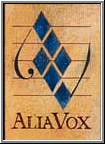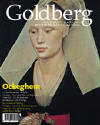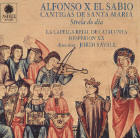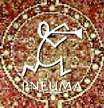|
Alfonso X El
Sabio
Cantigas de Santa Maria
Strela do dia |
|
/aliavox_heritage.jpg)
Vol. 20 |
|
Alia Vox AVSA9923
Code-barres/Barcode:
8435408099223 |
|
Édition remasterisée |
Remastered edition |
|
Super Audio CD |
|
|
/8435408099233.jpg)
|
Description
Artistes / Performers
Ensemble Hespèrion XX, La Capella Reial de Catalunya / direction: Jordi
Savall
Lieu d'enregistrement / Recording site:
Collégiale romane du Château de Cardona, Catalogne
Date d'enregistrement: février 1993
Recording date: February 1993
Durée totale / Total time: 70'15
Remasterisation: 2017

|
|
 |
|
 "Le terme cantiga (désigne) une
composition poético-musicale, sacrée et profane, en langue
galaïco-portugaise...
"Le terme cantiga (désigne) une
composition poético-musicale, sacrée et profane, en langue
galaïco-portugaise...
La thématique général des Cantigas est la narration de
miracles survenus par l'intercession de la Vierge..."
 The word cantiga
(is used) to describe a poetic-musical composition,
whether religious or secular, in the Galician-Portuguese
language... The general subject of the Cantigas is
the narration of the miracles brought about by the
intercession of the Virgin..."
The word cantiga
(is used) to describe a poetic-musical composition,
whether religious or secular, in the Galician-Portuguese
language... The general subject of the Cantigas is
the narration of the miracles brought about by the
intercession of the Virgin..."
|
|

Cantigas de Santa Maria
|

Cantigas de Santa Maria |
|

Extrait du livret / From the liner notes |
|
 En tant que législateur et instigateur d’ouvrages
juridiques, Alphonse X a suivi les traces de son père et réalisé
des projets planifiés et initiés par ce dernier. Il est tout à
fait possible que dans le domaine de la poésie l’exemple de ce
père (Ferdinand le Saint) lui ait aussi servi de stimulant. Comme
l’écrit son fils dans le Setenario et comme nous le savons
grâce à d’autres sources, le roi Ferdinand a été un grand mécène
de jongleurs fréquentant la cour castillane. Fait important, sa
profonde dévotion à la Vierge Marie est mentionnée dans trois
Cantigas (122, 221 et 292).
En tant que législateur et instigateur d’ouvrages
juridiques, Alphonse X a suivi les traces de son père et réalisé
des projets planifiés et initiés par ce dernier. Il est tout à
fait possible que dans le domaine de la poésie l’exemple de ce
père (Ferdinand le Saint) lui ait aussi servi de stimulant. Comme
l’écrit son fils dans le Setenario et comme nous le savons
grâce à d’autres sources, le roi Ferdinand a été un grand mécène
de jongleurs fréquentant la cour castillane. Fait important, sa
profonde dévotion à la Vierge Marie est mentionnée dans trois
Cantigas (122, 221 et 292).
Texte intégral de présentation rédigé en 2017 par Jordi Savall. (Cliquer
ici)
 The Cantigas de Santa Maria
(«Canticles of Holy Mary») are 420 poems with musical notation,
written during the reign of Alfonso X The Wise (1221–1284) and
often attributed to him. It is one of the largest collections of
monophonic songs from the Middle Ages and is characterized by the
mention of the Virgin Mary in every song.
The Cantigas de Santa Maria
(«Canticles of Holy Mary») are 420 poems with musical notation,
written during the reign of Alfonso X The Wise (1221–1284) and
often attributed to him. It is one of the largest collections of
monophonic songs from the Middle Ages and is characterized by the
mention of the Virgin Mary in every song.
Original essay written in
2017 by Jordi Savall
(Click
here)
|
|
Gramophone-
(__/____)
(English)
|

|
|
Analyste: Mary Berry
Condensé (traduction libre):
"Un enregistrement tout empreint de charme et de simplicité. Les
courtes mélodies modales sont irrésistibles... produisant ... un
effet incantatoire..."
Voilà qui nous semble bien résumer des
commentaires d'une neutralité très courtoise
|
Reviewer: Mary
Berry
Abridged version-:
"It is a recording of immense charm and simplicity. The short modal
melodies are compelling, even after the constant repetition of
multiple stanzas. The effect of these on the ear is rather like an
incantation and as two of these tunes occupy more than a third of
the entire recording one might expect the result to be monotonous.
Quite the contrary: some variety is introduced by the use of canon
or discreet accompaniment, but the melodies themselves (Muito faz
grand'erro and De toda chaga ben pode guarir) can bear
this constant repetition."
|
|
Goldberg
# 1, (Automne/Fall
1997)
(English) |
 |
Appréciation
  
Evaluation |
|
|
Reviewer: Sophie Roughol
Original text :
This commentary is a continuation of an article entitled "Cantiguas"
published in Goldberg (no. 1).
"Savall is always Savall, whatever the repertoire. His inclination
towards the hedonistic, the luxuriant, and the dazzling array of
colours and rythms, always maintain the force of irrepressible
seduction. His Cantiguas are the exact opposite of those of
Sequentia (Deutsche Harmonia Mundi
054722 77173 2 - 1991). You will find here no precise
historical reference, no contrast in inspiration. They are all cast
in the same mould, as though the codex followed only one form.
Indeed, both the vocal style and the instrumental realizations carry
the anachronistic stamp of a vaguely orientalizaing Hispanic
renaissance or pre-baroque, devilishly attractive but cautious. What
is the reality of the world which Savall evokes ? That of Sequentia,
more demanding, seem also to be the truest".
|
Quelques extraits du texte du livret, signé Jesus Martín Galán:
A few excerpts from the liner notes by Jesus Martín Galán:
|
Le terme cantiga ... (sert à) désigner une composition
poético-musicale, sacrée et profane en langue galaïco-portugaise...
Les Cantigas de Santa Maria, comprenant plus de quatre cents oeuvres
consacrées à la Vierge, furent sans doute rassemblées dans la
deuxième moitié du XIIIe s., entre 1250 et 1280, sous le contrôle du
roi de Castille de cette époque, Alphonse X "le Sage"...
"Sa tâche fut surtout d'organiser, diriger et corriger ..
(conséquemment) c'est donc à lui que semble revenir l'homogénéité
stylistique de l'oeuvre"...
"La thématique générale des Cantigas est la narration des miracles
survenus par l'intercession de la Vierge (appelés Cantigas de
miragre). Cependant, au fil du recueil, toutes les dix pièces, il en
apparaît une... qui possède une intention plus lyrique. Elles
appartiennent à celles qu'on appelle les Cantigas de loor, qui
louent la Vierge, qui la remercient de son rôle médiateur ou qui
chantent ses vertus". (CSM 100, CSM 400 sur le disque)
Jesus Martín Galán conclue son article en s'interrogeant sur les
motifs "... qui poussèrent le roi sage à rassembler systématiquement
des chansons en l'honneur de la Vierge..." Il répond en nous
rappelant que ce recueil a été constitué "à un moment où la poésie
troubadouresque est complètement associée à l'idée de l'amour
courtois (et que par conséquent) faire d'Alphonse X le Sage la
figure d'un troubadour qui chante sa dame idéalisée, la Vierge Marie
en personne, n'est pas du tout une idée erronée... Le concept
divinisé de la femme dans la poésie médiévale¹ a pu donner lieu à
l'apparition de cette littérature mariale... De ce point de vue, la
collection suppose fondamentalement la sacralisation du fin'amor
ou, pour citer Ismeal Fernández de la Cuesta, le transfert au divin
de l'attitude troubadouresque"
Traduction du texte original espagnol: Janine Lafont
Adaptation: "Classic @ la Carte" :
|
"The word cantiga... (is used) to
describe a poetic-musical composition, whether religious or secular, in the
Galician - Portuguese language...
"..the Cantigas de Santa Maria, with more than four hundred works
dedicated to the Virgin, must have been composed in the second half of the XIII
century, around 1250-80, under the direction of Alfonso X, "the Wise", who was
then King of Castille"... "His was the important work of organization, direction
and correction... (consequently) ... the stylistic unity of the work is also to
his merit"...
"The general subject of the Cantigas is the narration of the miracles
brought about bu the intercession of the Virgin (called Cantigas de miragre).
Throughout the collection, however, for every ten pieces there appears one...
which has a more lyrical purpose. These are known as the Cantigas de loor, in
which the Virgin Mary is praised, her role as a mediator is appreciated, or her
virtues are sung. (CSM 100, CSM 400 on the CD)
Jesus Martín Galán concludes his article by questionning the "...
motivations of the wise king to undertake the task of systematically assembling
songs in honour of the Virgin..." He answers by reminding us that the
collection was assembled "at a time when poetry of the troubadours was
completely associated with the idea of "courtly love", (and consequently)it must
not have been thought at all strange to see Alfonso X, the Wise as a troubadour
singing to his ideal lady, who is none other than the Virgin Mary... The exalted
concept of woman in Provençal poetry could have brought about the appearance of
this type of Marian literature... Seen in this light, the collection essentially
implies giving a sacred character to the fin'amor, or, to quote (Ismeal)
Fernández de la Cuesta, the transference of the troubadour attitude to the
divine"
Translation from the original Spanish text: Angela Buxton
Adaptation: "Classic @ la Carte"
|
|

41:4 (03-04/2018) |
|
 |
|
|
This is a reissue of
Astrée E 8508 (Fanfare 17:3)
with the addition of a cantiga made for a more recent thematic book,Jerusalem (32:5).
It has been a perennial best choice for a single disc of cantigas,
for Savall has a keen appreciation of the music, the subject matter,
and the era in which the works arose. His instrumental
accompaniments are well judged (there are very few unaccompanied
versions of the cantatas). Shortly after this first appeared,
Eduardo Paniagua began to record a complete set of the cantigas.
Some of them have been reviewed here, but after 36 CDs he is not
nearly finished, and most of them have never been distributed in
this country. His discs are not as well filled as this one, but he
invariably performs every verse of each cantiga, even a 50-verse
cantiga on a recent issue. He does take the shortcut of reciting
groups of verses in the longer works (as others have done as well).
Paniagua also includes instrumental versions of cantigas that,
sooner or later, are rendered in vocal performances, thus stretching
out the number of discs required for the eventual complete set.
On the Astrée
disc, Savall’s group sang eight cantigas, all complete, and played
four more (one of them twice, bookending the program). O
ffondo do mar,
the newly added recording, is sung with seven of its 12 verses. As
Alia Vox has done in systematically reissuing Savall’s older
recordings, the remastered Super Audio sound is stunning and the
packaging is lavish. This one has a 180-page book with texts, six
translations, three essays including the original one, and some
gorgeous color photographs as well as manuscript facsimiles. The
program includes one of the most beloved of the cantigas,Santa
Maria, strela do dia,
along with less familiar selections. The disc has long been one of
my favorite cantiga collections, and it is better than ever in this
presentation. J.
F. Weber
|
|

"Cantigas" by Sophie Roughol in Goldbgerg, # 1,
pp.43-49. (In English) (1997)
Excellent article with a comparative discography. |
~
Res Musica (12/2017)
~
Early Music Review |
| |
|
|
Autres références disponibles via la base de
données de Todd McComb/ Other available references via
Todd McComb's database:
(Site: http://www.medieval.org)
Re:
|
|
La musique / The music |
| CSM 176: Introductio |
CSM 037: Miragres fremosos faz por
nos |
| CSM 100: Santa Maria, strela do
dia |
CSM 77-119: Instrumental |
| CSM 400: Pero cantigas de loor |
CSM 126:De toda chaga ben pode guarir |
| CSM 123: Instrumental |
CSM 181: Pero que seja a gente |
| CSM 209: Muito faz grand'erro |
CSM 176: Conclusion
|
|
CSM 018: Por nos de dulta tirar |
|
| CSM 142: Instrumental |
|
| CSM 163: Pode por Santa Maria |
|
|
|
|
|
|
To order / Commander
Alia Vox AVSA9923
Code-barres/Barcode
:
8435408099223
*
WILL SHIP ANYWHERE IN THE WORLD
 EXPÉDITION PARTOUT DANS LE MONDE
EXPÉDITION PARTOUT DANS LE MONDE |
| |
|
La viole de
gambe
Parutions
récentes |
Viola da gamba
Recent
releases |

/8435408099233.jpg)

/N9940_small.jpg)




